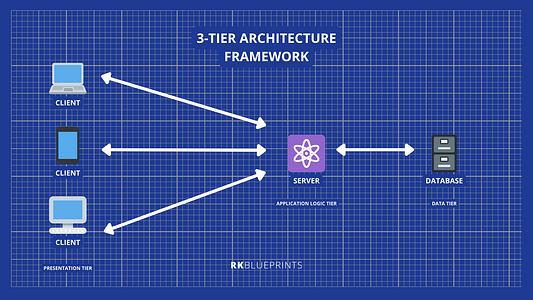What is the 3-Tier Architecture Framework?
At its core, the 3-Tier Architecture framework separates an application into three independent layers, each with its own distinct responsibilities. This separation ensures better scalability, improved security, and ease of maintenance.
1. Presentation Tier
This is the front-facing user interface (UI) of your application. It’s what users interact with — whether it’s a website, a mobile app, or a desktop application. The primary responsibilities of the presentation tier are:
- Displaying information to the user.
- Capturing user inputs.
- Sending inputs to the logic tier for processing.
Think of it as the gateway to your application, ensuring a seamless experience for users.
2. Logic Tier
The logic tier, also known as the application or business logic layer, is the brain of your application. It:
- Processes the user inputs received from the presentation tier.
- Executes business logic, such as calculations or decision-making processes.
- Acts as the bridge between the presentation and data tiers.
By isolating the business logic in this layer, you ensure that the logic is reusable and independent of the UI.
3. Data Tier
The data tier is the backbone of the architecture, responsible for:
- Storing, managing, and retrieving application data.
- Ensuring data security and integrity.
- Handling queries and updates from the logic tier.
This layer typically involves databases or other storage solutions and is designed to keep sensitive data secure and accessible only when needed.
Benefits of the 3-Tier Architecture
The 3-Tier Architecture offers several advantages that make it a go-to choice for developers and organizations:
- Scalability
Each tier can be scaled independently to handle growing user demands. For example, if you experience high traffic, you can scale the presentation tier without impacting the data or logic tiers. - Maintainability
By separating concerns, developers can work on one tier without affecting the others. This modularity simplifies debugging, testing, and updating your application. - Improved Security
Sensitive data can be isolated in the data tier, reducing the risk of exposure. Additionally, access control measures can be implemented at each layer. - Flexibility
The 3-Tier model allows for the use of different technologies in each layer, providing flexibility in tool selection and integration.
Real-World Examples of 3-Tier Architecture
To understand the practical applications of 3-Tier Architecture, let’s look at some examples:
- E-Commerce Websites: Platforms like Amazon and Shopify utilize the presentation tier for their user interface, the logic tier for order processing and recommendations, and the data tier for storing product and customer data.
- Banking Applications: Mobile banking apps use the presentation tier for the user interface, the logic tier for executing transactions, and the data tier for storing account details.
- Online Learning Platforms: Sites like Coursera or Udemy separate the user-facing interface, course recommendation algorithms, and content databases into the three layers.
A Blueprint of 3-Tier Architecture
Lets use a sleek blueprint diagram framework to visually showcase the following elements:
- Presentation Tier (client): Provides the front-end user interface.
- Application Logic Tier (server): Houses the business logic that is used to process user inputs.
- Data Tier (database): Backend of a web application that runs on database management software.

Building 3-Tier Applications with AWS Elastic Beanstalk
Deploying and managing a 3-Tier Architecture application can be complex, but tools like AWS Elastic Beanstalk simplify the process. Elastic Beanstalk is a fully managed service that allows you to deploy and scale web applications with minimal effort.
Getting Started with AWS Elastic Beanstalk
Launch Your Application
Elastic Beanstalk handles the heavy lifting of provisioning infrastructure, load balancing, and monitoring. You simply upload your application code, and AWS takes care of the rest.
Key Features
- Automatic Scaling: Scale each tier independently to match user demand.
- Monitoring and Logging: Stay informed about your application’s performance through AWS CloudWatch.
- Support for Multiple Frameworks: Elastic Beanstalk supports popular languages like Java, Python, and Node.js.
Hands-On with the AWS Management Console
Raheem demonstrates the intuitive AWS Management Console, showing how easy it is to create and manage projects in Elastic Beanstalk. The console allows you to:
- View existing projects.
- Create new projects in minutes.
- Monitor application performance and make adjustments as needed.
Why Elastic Beanstalk for 3-Tier Applications?
AWS Elastic Beanstalk aligns perfectly with the 3-Tier Architecture model. It allows you to focus on your application code while AWS handles the infrastructure, making it ideal for both beginners and experienced developers.
Conclusion
The 3-Tier Architecture framework is a proven design pattern for building scalable, maintainable, and secure applications. By separating concerns into the presentation, logic, and data tiers, it provides a foundation for long-term success. Tools like AWS Elastic Beanstalk make deploying and managing 3-Tier applications more accessible than ever, enabling developers to focus on innovation rather than infrastructure.
So, Architects, it’s your turn to put this knowledge into practice. Dive into the AWS Elastic Beanstalk console, start building your 3-Tier application, and experience the power of this framework firsthand. The possibilities are endless — go create something amazing!
Check out the RK Blueprints technology series, appArchitect: Crafting Blueprints for Implementation, to learn even more — don’t miss out.







Recent Comments